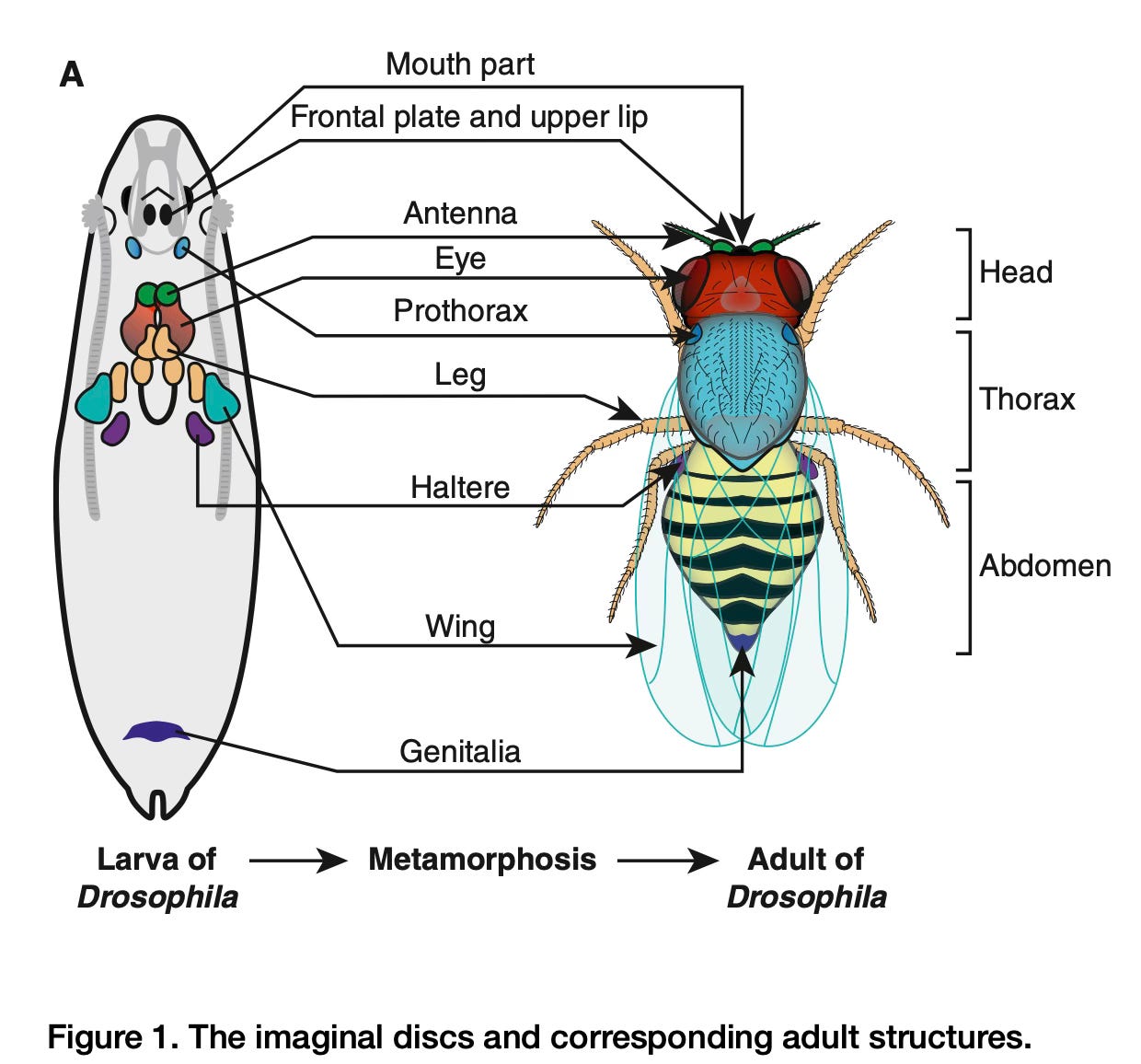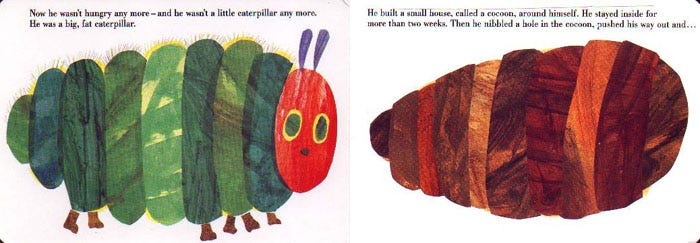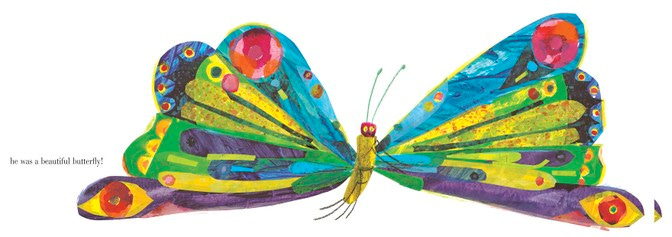The past few years, on the cusp of each new year, I’ve chosen a ‘word of the year’ — a word representing a curiosity or inquiry for the year to come. 2022 was trust. 2023 was integrity. This year, the word I chose—in a tongue-in-cheek way at eight months pregnant that felt magnetic, inevitable, and more than a little daunting—was metamorphosis.
The thing about this ‘word of the year’ practice is that the word, by the end of a year—tired, stretched out, lived-in—tends to look like, and mean, something radically different to me than it did when first chosen. Eight months into 2024, my understanding of metamorphosis is itself metamorphosed.
Traditional narratives of transformation-as-metamorphosis tend to revolve around a somewhat-mystical rupture between a before and an after. I’m reminded of this when I read The Very Hungry Caterpillar with my daughter (who, seemingly inspired by the very hungry caterpillar himself, desperately wants to eat the board book). On one page is the brown husk of the chrysalis. On the next, the technicolor winged butterfly.
Another popular narrative rendering of metamorphosis emphasises dissolution. It goes something like this: the caterpillar dissolves into an amorphous goop/soup before emerging, transformed. We might call this goop/soup a liminal state, a neither this nor that, somewhere between what was and what will be.
I recently learned* about a third way of understanding metamorphosis—and the goop/soup—which hedges more closely to the developmental biology of insects and is, I think, extremely useful for metamorphosis-as-metaphor: imaginal discs. (*shoutout to my brother who introduced this to me, by way of his amazing fiancé—a biologist and Director of Exhibit Development at the Exploratorium science museum in San Francisco)

Imaginal discs are sac-like cell structures found within insect larvae. During the dissolution of the larva into the goop/soup of metamorphosis, almost all the larval tissues degenerate, except for these imaginal discs. These discs, lying dormant waiting for their moment, become activated during metamorphosis. They differentiate and proliferate rapidly, becoming the eventual form and outside structure of the butterfly: an antenna, an eye, a wing.
Interestingly, the larval immune system first attacks the imaginal discs, recognising them as foreign bodies. Yet as the discs divide with increasing speed, they eventually overwhelm the caterpillar — even using the soup itself as the raw materials for the structures they are becoming.
What I like about imaginal discs as metaphor is that they disrupt the common narrative of metamorphosis merely as transformation: from one form to another. Instead, form itself is abandoned, all the way down to the most essential units. Units that were there all along, previously unremarkable and unnoticed yet base in the sense of foundational, become the driving force of a structural and physiological evolution.
I also find the immune system’s response—to attack these imaginal discs—to be oddly endearing and relatable: sometimes we do not recognise the base units of our becoming as part of ourselves. Sometimes our instinct is to resist, to attack. Sometimes we think our survival depends on it. And sometimes, this instinct is more in service of the survival of a no-longer form we’re still clinging to, than the one we are becoming.
***
Rebecca Solnit, writing in The Guardian in the early days of the pandemic, uses the metaphor of imaginal discs to comment upon a society in crisis, caught in the crosshairs of metamorphosis. “May the best among us,” she writes, “the most visionary, the most inclusive, be the imaginal cells – for now we are in the soup.”
Lucy Jones, also writing during the pandemic in an essay about land ownership, nature deprivation, and urban development in Emergence, asks these vital questions:
“What imaginal discs do we want to hold with us, in this liminal space? Can we bring the expanded connection to the rest of nature that many have experienced during lockdown into the new world, seeing the living world in a new way, as kin, rather than something separate?”
I wonder, though, if it is so agentive: if we—on an individual or societal level—get to choose our imaginal cells/discs, or if they choose us? Or rather, if we “hold with” them, or if they “hold up” us?
***
When I first thought about the concept of metamorphosis in relation to becoming a mother, I had really only been focusing on (/dreading?) The Soup. That I would dissolve into something unrecognisable, that my brain would irrevocably change the way it worked (spoiler alert: it has, though not entirely negatively—emerging neuroscience about changes to the maternal brain are fascinating), an irrational yet outsized fear that I wouldn’t remember how to write. Somewhere shortly after the end of the “fourth trimester” still very much sleep-deprived, still very much healing from giving birth, I remember thinking—damn, I am still very much in this soup.
I had been thinking of the dissolution and the emergence as two discreet phases, an entering of The Soup, and an eventual exit into something else. I didn’t realise that inside the soup itself would not only be a profound space of reorganisation and discarding, but also that something within me would somehow drive that process of rearrangement, would become the defining structures of this new form.
Returning to paid work—my job as an assistant professor—last week, after 7 months of maternity leave (months which impacted me profoundly, in ways I’m still integrating), has somehow set my awareness of these imaginal discs into action. It’s a shift I’m finding more unsettling than I expected. Re-entering my workplace, which feels more or less identical to when I left in December (while I certainly do not), there is still an embodied memory—an internal expectation—of The Way I Used to Do Things. The way I could steer my attention, that once-renewable resource, nearly wholly. The way I could delude myself that time was something I could actually master. That self feels far away. That form is no longer.
Now, trying to cognitively remember to schedule 20-minute blocks for pumping into a day full of research meetings before my body reminds me, my brain feels permanently fractured with one room living out a parallel universe with my daughter, wondering what she’s doing/thinking/feeling. When I get home to her (she’s with Tobias who is now on paternity leave), I get a front-row seat to witness her own metamorphoses—what a dear friend called “baby software updates”—in ways I couldn’t see when we were together every minute of the day. The ways a wiggle one day becomes the semblance of a crawl the next. The way a proto-giggle, once only in reaction to something I did, is now a full-blown laugh when she reaches out to touch my nose, a first glimpse at her own sense of humor. She, too, has her own discs set in motion.
In moving beyond the often-singular focus of those early months of motherhood, meeting myself as both mother and all that I am including and beyond that, has me facing the ways dormant parts of me—my imaginal discs, if you will—have all along been quietly rearranging themselves. It’s only now I’m beginning to perceive this process consciously. Sometimes it feels like I’m moving house, sifting through the detritus of dusty cardboard boxes from a past life and deciding what to keep. Or rather, the house is me, and the boxes are rearranging themselves, like the keys of a self-playing piano. Some of the discs driving my rearrangement will be cognisant to me; others will feel surprising. Some will make me proud, others will haunt me.
The metaphor, of course, has its limits. I have no pretenses about emerging into anything remotely resembling a butterfly (ha), and am becoming less and less convinced by the illusion of a fixed “self” as some sort of metamorphosed-destination. What is life if not an endless series of mini- (or meta-?) metamorphoses?
Still, the concept of imaginal discs reminds me not to outsize my focus on the dissolution as the most interesting thing about a metamorphosis. To try to enter into a trusting relationship with it, even (especially) if it is a process I cannot consciously steer. To get to know my “discs” as they make themselves known to me. To let them, let me, both find form and release it. To trust that mess can be raw material. To remember that there are parts of ourselves we have yet to meet, which may have been there all along, which may know something we have yet to learn, see, feel, be.
Writing Prompt:
What are your imaginal discs? What, in other words, becomes the scaffolding from within you, when the rest of you dissolves?
bits and bobs—
While WITHIN—my seasonal workshop series on writing from/through/into the body—is on pause until 2025, I’m honoured to be a guest teacher in Claudia Menger and Rachel Brownbridge’s 80-hour Yoga Nidra and Deep Rest Teacher Training. Claudia and Rachel’s program, truly one of a kind, is so intelligently and thoughtfully crafted, and I’m quite excited be teaching a class on somatic writing and yoga Nidra on November 10th. The training begins September 19th, and if you’re a last-minute person like me, there are still 2 spots remaining—learn more and register here.
I found Nada Alic’s recent essay “Baby Brain” in The Beyond Noise, about reclaiming time—and self—in first-time early motherhood, supremely relatable as I return to work. Particularly this:
“Some days I want to lobotomise the part of my brain that thinks of anything other than him. I’d give it all up and spend my days watching his eyelashes grow. Then, I’ll wake up from the dream of milk and baths and rocking and remember myself. I’ll remember that I need to write. I also need to make money. Even if I didn’t, preserving my stubborn desire to create is a way of safeguarding my son’s individuation. Without it, the mother instinct in me threatens to cannibalise us both. There’s an elegance and artfulness in knowing when to turn away from him and when to return.”
My friend Alex and her sister Millie recently launched Pretty Sporty, a Substack for sports news without the gatekeeping, recently with a focus on the NFL, Formula 1, and the Tennis:
Thank you, always, for reading, for being here, for the gift of your presence and time. You’ll hear from me again very soon (sooner than usual!) — I have a few essays being published this fall that I look forward to sharing with you here, along with a backlogged “Drafts” folder on Substack I hope to sift through…
Till then, wishing you a restful Late Summer weekend.
With heart,
Allie








Great piece, and hits home pretty closely for me, as I am nearing the end of the “fourth trimester” myself and I’ll admit, one of my ongoing irrational fears was/is that I’ll never be able to write (read/ focus/ work) the same as I used to before baby… but this gives me much encouragement :)
As for a stable self, I’ve long taken a more fluid take on “selfhood”, but I think pregnancy and motherhood are, if nothing else, have been undoing and reorganizing and remaking forces for me in ways that I frankly didn’t expect. I’m still in the Soup, as it were, but I have glimmers of the other side, and I love this way of thinking about it!
Always such a pleasure reading your letters.